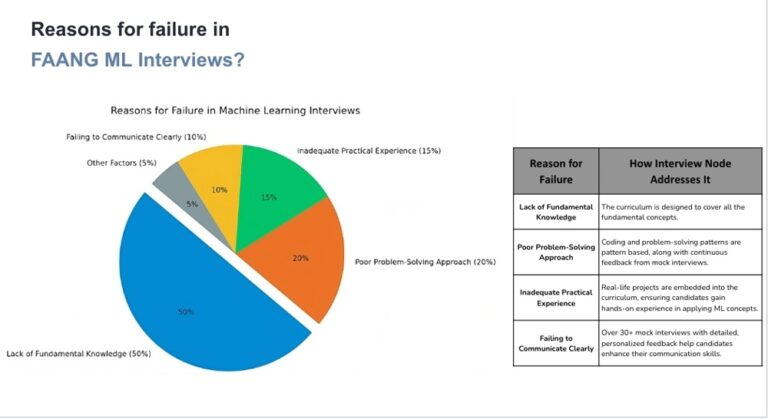Introduction
In today's tech-driven world, top machine learning algorithms have become essential knowledge for software engineers. According to a report by LinkedIn, the demand for ML engineers grew by nearly 74% annually over the past few years, outpacing other technical roles. Top companies like Google, Amazon, and Facebook are on the lookout for engineers who not only understand the theory behind ML but can also apply this knowledge in real-world scenarios.
Mastering key ML algorithms is a vital part of acing these interviews. These algorithms form the backbone of ML models, and understanding them is crucial to showcasing your expertise. Whether it's through coding challenges or problem-solving questions, interviewers will test your ability to apply these algorithms effectively.
This blog will guide you through the top 10 machine learning algorithms you need to know to succeed in interviews at leading tech firms.
Algorithm #1: Linear Regression
Linear Regression is one of the simplest yet most powerful algorithms in machine learning. It's a supervised learning technique used for predicting a continuous output variable based on one or more input features. The simplicity of Linear Regression lies in its assumption of a linear relationship between the dependent and independent variables, making it easy to interpret and implement.
Use Case in Interviews
Interviewers often favor Linear Regression because it lays the foundation for understanding more complex algorithms. It is frequently used in scenarios where you need to predict numerical outcomes, such as sales forecasting or predicting house prices. Being able to explain the model's assumptions, perform residual analysis, and discuss model performance metrics like R-squared are crucial skills that interviewers look for.
A survey by Glassdoor found that questions on Linear Regression were among the top 5 most commonly asked in data science and ML interviews, particularly in tech companies.
Algorithm #2: Logistic Regression
Logistic Regression is a fundamental algorithm used for binary classification tasks. Despite its name, Logistic Regression is used to predict categorical outcomes rather than continuous ones. By applying the logistic function, it models the probability that a given input belongs to a particular class.
Use Case in Interviews
Logistic Regression is a go-to algorithm for interviewers because of its applicability to classification problems, which are common in machine learning tasks. You might be asked to implement this algorithm from scratch, discuss its assumptions, or compare it with other classifiers like Decision Trees or SVMs.
According to Indeed's job trends, positions requiring proficiency in classification tasks have grown by 67% in the last three years, highlighting the importance of algorithms like Logistic Regression in the job market.
Algorithm #3: Decision Trees
Decision Trees are a versatile and powerful tool for both classification and regression tasks. They work by splitting the data into subsets based on the most significant attributes, making them easy to interpret and visualize.
Use Case in Interviews
Questions on Decision Trees are common in ML interviews because they test a candidate's ability to build, prune, and evaluate tree models. Interviewers may also explore your understanding of entropy, information gain, and the trade-offs between overfitting and underfitting.
A study by Towards Data Science found that Decision Trees are used in over 70% of explainable AI models, underlining their importance in creating interpretable ML solutions.
Algorithm #4: Random Forest
Random Forest is an ensemble learning method that builds multiple Decision Trees and merges them to get a more accurate and stable prediction. It's particularly well-suited for handling data with high variance and can improve the performance of models with complex interactions among features.
Use Case in Interviews
Interviewers often probe into Random Forest to assess your understanding of ensemble methods. You may be asked about the advantages of Random Forest over a single Decision Tree, how to tune hyperparameters, and the importance of techniques like bagging.
In a Kaggle survey, Random Forest was ranked as one of the top 3 algorithms used by data scientists across various industries, demonstrating its practical value in real-world applications.
Algorithm #5: Support Vector Machines (SVM)
Support Vector Machines are powerful for classification tasks, especially when the classes are not linearly separable. SVM works by finding the hyperplane that best separates the classes, maximizing the margin between them.
Use Case in Interviews
SVM is favored in interviews for its conceptual depth. Candidates may be asked to explain how the algorithm works, discuss the kernel trick, and solve problems involving non-linear decision boundaries.
A report by Analytics India Magazine noted that SVMs are extensively used in fields like image recognition, where they have been shown to outperform other classifiers in certain cases.
Algorithm #6: K-Nearest Neighbors (KNN)
K-Nearest Neighbors is a non-parametric algorithm used for classification and regression. It operates by finding the k-nearest data points in the feature space and assigning a class based on the majority vote.
Use Case in Interviews
Interviewers use KNN to test your understanding of distance metrics, feature scaling, and computational efficiency. KNN is straightforward to understand but can be challenging to implement effectively in large datasets, which may be a point of discussion.
KNN is widely used in recommendation systems and anomaly detection, as noted in a survey by Data Science Central, emphasizing its relevance in real-world ML applications.
Algorithm #7: K-Means Clustering
K-Means Clustering is an unsupervised learning algorithm used to partition data into k distinct clusters based on feature similarity. It's particularly useful for tasks like customer segmentation and image compression.
Use Case in Interviews
Interviewers might test your ability to implement the K-Means algorithm, optimize the number of clusters using the elbow method, and handle cases where clusters are not well-separated.
According to a study published in the Journal of Machine Learning Research, K-Means remains one of the most commonly used clustering algorithms in data mining applications.
Algorithm #8: Principal Component Analysis (PCA)
Principal Component Analysis is a dimensionality reduction technique that transforms a large set of variables into a smaller one that still contains most of the original information. It's particularly useful for reducing the computational complexity of ML models.
Use Case in Interviews
PCA is often brought up in interviews when discussing high-dimensional datasets. Candidates might be asked to perform PCA on a given dataset, interpret the resulting components, and discuss the trade-offs between dimensionality reduction and information loss.
A study by IBM found that using PCA can reduce model training time by up to 40% without significantly impacting accuracy, highlighting its importance in large-scale ML applications.
Algorithm #9: Neural Networks
Neural Networks are at the heart of deep learning and are designed to recognize patterns in data through layers of interconnected neurons. They are particularly effective in complex tasks like image recognition, natural language processing, and autonomous driving.
Use Case in Interviews
Given their complexity, Neural Networks are a popular topic in interviews, especially in companies focusing on AI and deep learning. Candidates might be asked to explain how backpropagation works, discuss various activation functions, or design a neural network for a specific problem.
According to a LinkedIn report, job postings requiring deep learning skills have grown 35 times since 2015, underscoring the importance of Neural Networks in the current job market.
Algorithm #10: Gradient Boosting Machines (GBM)
Gradient Boosting Machines are a powerful ensemble technique that builds models sequentially, with each new model correcting the errors of the previous ones. This makes GBM highly effective for both regression and classification tasks.
Use Case in Interviews
Interviewers often explore GBM to assess your understanding of boosting techniques, overfitting prevention, and the trade-offs between model performance and computational cost. Knowledge of popular GBM implementations like XGBoost or LightGBM is also frequently tested.
In multiple Kaggle competitions, GBM-based models have consistently outperformed other algorithms, making them a staple in the toolkit of data scientists.
Preparing for Success in ML Interviews
Mastering these top 10 machine learning algorithms is essential for success in ML interviews at leading tech companies. Each algorithm offers unique advantages and challenges, and being well-versed in them will give you a significant edge. Practice implementing these algorithms, understand their theoretical underpinnings, and stay updated on their applications in the industry.
For more tailored guidance and resources, explore the offerings at InterviewNode to take your ML interview preparation to the next level.






